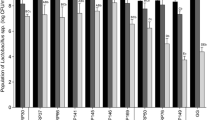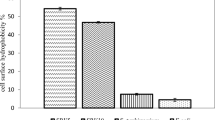Abstract
The search for probiotic candidates among lactic acid bacteria (LAB) isolated from food may uncover new strains with promising health and technological properties. Lactobacillus mucosae strains attracted recent research attention due to their ability to adhere to intestinal mucus and to inhibit pathogens in the gastrointestinal tract, both related to a probiotic potential. Properties of interest and safety aspects of three Lb. mucosae strains (CNPC006, CNPC007, and CNPC009) isolated from goat milk were investigated employing in vitro tests. The presence of genetic factors related to bile salt hydrolase production (bsh), intestinal adhesion properties (msa, map, mub, and ef-tu), virulence, and biogenic amine production were also verified. All strains exhibited the target map, mub, and ef-tu sequences; the msa gene was detected in CNPC006 and CNPC007 strains. Some of the searched sequences for virulence factors were detected, especially in the CNPC009 strain; all strains carried the hyl gene, related to the production of hyaluronidase. Lb. mucosae CNPC007 exhibited a high survival rate in simulated gastric and enteric conditions. Besides, all strains exhibited the bsh sequence, and CNPC006 and CNPC007 were able to deconjugate salts of glycodeoxycholic acid (GDC). Regarding technological properties for dairy product applications, a relatively higher milk acidification and clotting capacity, diacetyl production, and proteolytic activity were registered for CNPC007 in comparison to the other strains. Collectively, the results aim at Lb. mucosae CNPC007 as a promising probiotic candidate for application in dairy products, deserving further studies to confirm and explore its potential.
Similar content being viewed by others
References
Alexandraki V, Tsakalidou E, Papadimitriou K, Holzapfel W (2013) Status and trends of the conservation and sustainable use of microorganisms in food processes. FAO Commission on Genetic Resources for Food and Agriculture, Background Study Paper No. 65
FAO/WHO—Food and Agriculture Organization of the United Nations/World Health Organization (2002) Working Group Report on Drafting Guidelines for the Evaluation of Probiotics in Food. Guidelines for the evaluation of probiotics in food. Food and Agriculture Organization of the United Nations. London, April 30 and May 1, 2002
Vizoso-Pinto MG, Franz CMAP, Schillinger U, Holzapfel WH (2006) Lactobacillus spp. with in vitro probiotic properties from human faeces and traditional fermented products. Int J Food Microbiol 109:205–214
London L, Price NPJ, Ryan P, Wang L, Auty MAE, Fitzgerald GF, Stanton C, Ross RP (2014) Characterization of a bovine isolate Lactobacillus mucosae DPC 6426 which produces an exopolysaccharide composed predominantly of mannose residues. J Appl Microbiol 117:509–517
Etzold S, Kober OI, MacKenzie DA, Tailford LE, Gunning P, Walshaw J, Hemmings AM, Juge N (2014) Structural basis for adaptation of lactobacilli to gastrointestinal mucus. Environ Microbiol 16:888–903
Lavilla-Lerma L, Pérez-Pulido R, Martínez-Bueno M, Maqueda M, Valdivia E (2013) Characterization of functional, safety, and gut survival related characteristics of Lactobacillus strains isolated from farmhouse goat's milk cheeses. Int J Food Microbiol 163:136–145
Roos S, Karner F, Axelsson L, Jonsson H (2000) Lactobacillus mucosae sp. nov., a new species with in vitro mucus-binding activity isolated from pig intestine. Int J Syst Evol Microbiol 50:251–258
Bilková A, Dubničková M, Sepová HK (2013) Antimicrobial susceptibility and immunomodulatory properties of lamb isolate of Lactobacillus mucosae, new probiotic candidate. Acta Fac Pharm Univ Comen 60:1–6
Bleckwedel J, Terán LC, Bonacina J, Saavedra L, Mozzi F, Raya RR (2014) Draft genome sequence of the mannitol-producing strain Lactobacillus mucosae CRL573. Genome announc 2:e01292–e01214
Branton WB, Jones ML, Tomaro-Duchesneau C (2011) In vitro characterization and safety of the probiotic strain Lactobacillus reuteri NCIMB 30242. Int J Probiotics 6:1–12
EFSA—European Food Safety Authority (2012) Panel on Additives and Products or Substances used in Animal Feed (FEEDAP), Guidance on the assessment of bacterial susceptibility to antimicrobials of human and veterinary importance. EFSA Journal 10
dos Santos KMO, Vieira AD, Buriti FA, Nascimento J, Melo M, Bruno L, Borges MF, Rocha C, Souza Lopes A, Franco BDGM, Todorov SD (2015) Artisanal Coalho cheeses as source of beneficial Lactobacillus plantarum and Lactobacillus rhamnosus strains. Dairy Sci Technol 95:209–230
Felske A, Akkermans ADL, De Vos WM (1998) Quantification of 16S rRNAs in complex bacterial communities by multiple competitive reverse transcription-PCR in temperature gradient gel electrophoresis fingerprints. Appl Environ Microbiol 64:871–879
Todorov SD (2010) Diversity of bacteriocinogenic lactic acid bacteria isolated from boza, a cereal-based fermented beverage from Bulgaria. Food Control 21:1011–1021
Charteris WP, Kelly PM, Morelli L, Collins JK (1998) Development and application of an in vitro methodology to determine the transit tolerance of potentially probiotic Lactobacillus and Bifidobacterium species in the upper human gastrointestinal tract. J Appl Microbiol 84:759–768
Perin LM, Miranda RO, Todorov SD, Franco BDG, Nero LA (2014) Virulence, antibiotic resistance and biogenic amines of bacteriocinogenic lactococci and enterococci isolated from goat milk. Int J Food Microbiol 185:121–126
Lam SK, Ng TB (2011) First report of an anti-tumor, anti-fungal, anti-yeast and anti-bacterial hemolysin from Albizia lebbeck seeds. Phytomed 18:601–608
Jensen H, Grimmer S, Naterstad K, Axelsson L (2012) In vitro testing of commercial and potential probiotic lactic acid bacteria. Int J Food Microbiol 53:216–222
Taranto MP, de Ruiz Holgado AP, de Valdez GF (1995) Bile salt hydrolase activity in Enterococcus faecium strains. Microbiol Aliment Nut 13:375–379
Zago M, Fornasari ME, Carminati D, Burns P, Suàrez V, Vinderola G, Reinheimer J, Giraffa G (2011) Characterization and probiotic potential of Lactobacillus plantarum strains isolated from cheeses. Food Microbiol 28:1033–1040
Todorov SD, Botes M, Guigas C, Schillinger U, Wiid I, Wachsman MB, Holzapfel WH, Dicks LMT (2008) Boza, a natural source of probiotic lactic acid bacteria. J Appl Microbiol 104:465–477
Bradford MM (1976) A rapid and sensitive method for the quantitation of microgram quantities of protein utilizing the principle of protein-dye binding. Anal Biochem 72:248–254
Church FC, Swaisgood HE, Porter DH, Catignani GL (1983) Spectrophotometric assay using o-phthaldialdehyde for determination of proteolysis in milk and isolated milk proteins. J Dairy Sci 66:1219–1227
Hebert EM, Raya RR, Tailliez P, Giori GS (2000) Characterization of natural isolates of Lactobacillus strains to be used as starter cultures in dairy fermentation. Int J Food Microbiol 59:19–27
Harrigan WF (1998) Laboratory methods in food microbiology, 3 edn. Academic Press, San Diego
Mathur S, Singh R (2005) Antibiotic resistance in food lactic acid bacteria—a review. Int J Food Microbiol 105:281–295
Franz CMAP, Hummel A, Holzapfel WH (2005) Problems related to the safety assessment of lactic acid bacteria starter cultures and probiotics. Mitteil Geb Lebensm Hyg 96:39–65
Munoz-Atienza E, Gomez-Sala B, Araujo C, Campanero C, Del Campo R, Hernandez P, Herranz C, Cintas LM (2013) Antimicrobial activity, antibiotic susceptibility and virulence factors of lactic acid bacteria of aquatic origin intended for use as probiotics in aquaculture. BMC Microbiol 24:15
Jiménez E, Ladero V, Chico I, Maldonado-Barragán A, López M, Martín V, Fernández L, Fernández M, Álvarez MA, Torres C, Rodríguez JM (2013) Antibiotic resistance, virulence determinants and production of biogenic amines among enterococci from ovine, feline, canine, porcine and human milk. BMC Microbiol 13:288
Cotter PD, Hill C (2003) Surviving the acid test: responses of gram-positive bacteria to low pH. Microbiol Mol Biol Rev 67:429–453
Vinderola G, Capellini B, Villarreal F, Suarez V, Quibero A, Reinheimer J (2008) Usefulness of a set of simple in vitro tests for the screening and identification of probiotic candidate strains for dairy use. LWT - Food Sci Technol 41:1678–1688
De Smet I, Van Hoorde L, Vande Woestyne M, Cristianes H, Verstraete W (1995) Significance of bile salt hydrolytic activities of lactobacilli. J Appl Bacteriol 79:292–301
Taranto MP, Sesma F, Valdez GF (1999) Localization and primary characterization of bile salt hydrolase from Lactobacillus reuteri. Biotechnol Lett 21:935–938
Jones ML, Martoni CJ, Parent M, Prakash S (2012) Cholesterol-lowering efficacy of a microencapsulated bile salt hydrolase-active Lactobacillus reuteri NCIMB 30242 yoghurt formulation in hypercholesterolaemic adults. Br J Nutr 107:1505–1151
Buck BL (2006) Functional analysis of adhesion factors and signaling mechanisms in Lactobacillus acidophillus NCFM. Dissertation, Faculty of North Carolina State University in Microbiology
Pretzer G, Snel J, Molenaar D, Wiersma A, Bron PA, Lambert J, Van Der Meer R, Kleerebezem M (2005) Biodiversity-based identification and functional characterization of the mannose-specific adhesin of Lactobacillus plantarum. J Bacteriol 187:6128–6136
Hidalgo-Morales M, Robles-Olvera V, Garcia HS (2005) Lactobacillus reuteri β-galactosidase activity and low milk acidification ability. Can J Microbiol 51:261–267
Giraffa G (2003) Functionality of enterococci in dairy products. Int J Food Microbiol 88:215–222
Beganović J, Kos B, Pavunc AL, Uroić K, Džidara P, Sušković J (2013) Proteolytic activity of probiotic strain Lactobacillus helveticus M92. Anaerobe 20:58–64
Georgieva R, Iliev I, Haertle T, Chobert J, Ivanova I, Danova S (2009) Technological properties of candidate probiotic Lactobacillus plantarum strains. Int Dairy J 19:696–702
Ciocia F, McSweeney PLH, Piraino P, Parente E (2013) Use of dairy and non-dairy Lactobacillus plantarum, Lactobacillus paraplantarum and Lactobacillus pentosus strains as adjuncts in cheddar cheese. Dairy Sci Technol 93:623–640
Bonczar G, Wszolek M, Siuta A (2002) The effects of certain factors on the properties of yoghurt made from ewe’s milk. Food Chem 79:85–91
Rincon-Delgadillo MI, Lopez-Hernandez A, Wijaya I, Rankin SA (2012) Diacetyl levels and volatile profiles of commercial starter distillates and selected dairy foods. J Dairy Sci 95:1128–1139
Acknowledgements
The authors want to express their gratitude to Terezinha Fernandes Duarte and João Ricardo Furtado for providing technical assistance in the reported experimental research. This project and authors were supported by the Brazilian Agricultural Research Corporation (EMBRAPA), Conselho Nacional de Desenvolvimento Científico e Tecnológico (CNPq), and Fundação de Amparo à Pesquisa do Estado de Minas Gerais (FAPEMIG).
Author information
Authors and Affiliations
Corresponding author
Ethics declarations
Conflict of Interest
The authors declare that they have no conflict of interest.
Rights and permissions
About this article
Cite this article
de Moraes, G.M.D., de Abreu, L.R., do Egito, A.S. et al. Functional Properties of Lactobacillus mucosae Strains Isolated from Brazilian Goat Milk. Probiotics & Antimicro. Prot. 9, 235–245 (2017). https://doi.org/10.1007/s12602-016-9244-8
Published:
Issue Date:
DOI: https://doi.org/10.1007/s12602-016-9244-8




